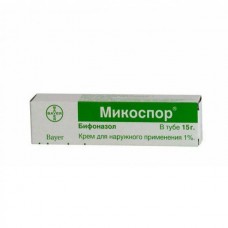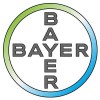Expiration date: 05/2026
Structure and Composition:
Mycospor
Cream for external application of 1%. 100 g contains bifonazole 1 g micronized
Excipients (in 1 g of cream): benzyl alcohol - 2 g cetostearyl alcohol (cetyl alcohol - 60%, stearyl alcohol - 40%) - 10 g of cetyl palmitate - octyldodecanol 3 g - 13.5 g Polysorbate 60 - 1.50 g of sorbitan stearate - 2 g purified water - 100 g
in the aluminum tube, 15 g in a box 1 tube.
Topical solution 15 ml. 100 ml contains 1 g of bifonazole
Other ingredients: ethyl alcohol 96% - 30 g of isopropyl myristate - 52.60 g
in a bottle dropper 15 ml vial in a box 1.
Mycospor Set
Ointment for external application. 100 g contains:
1 g of bifonazole
40 g of urea
Excipients: beeswax white - 5 g White Vaseline - lanolin 34 g - 20 g
in a tube of 10 g (complete with pump, water-resistant plaster, scraper) in the paper cartons 1 set.
Description pharmaceutical form:
Mycospor
Cream: a uniform, white color.
The solution: clear, colorless to yellowish.
Mycospor Set
Ointment: homogeneous, white with a yellowish tinge.
Pharmacokinetics:
Bifonazole well into the affected skin layers. After 6 hours after administration of various concentrations of the skin layers reach 1000 mg / cm3 in the upper layer of the epidermis (stratum corneum) to 5 g / cm3 in the papillary layer. Thus, all concentrations are obtained within the range of antifungal activity.
When applied to intact skin absorbed bifonazole small amount (0.6-0.8% of the dose) bifonazole concentration levels in plasma while always below the detection limit (i.e. <1 ng / ml). Negligible absorbance detected only after application to inflamed skin bifonazole (4.2% of dose). Thus, as bifonazole are very low concentration when applied topically (typically less than 5 ng / ml) in the blood plasma, no systemic effects are observed. The duration of stay in the skin (for certain protective action against fungal infections in guinea pigs) for the cream is 48-72 hours for a solution -. 36-48 h bifonazole crosses the placental barrier in rats.
Description of the pharmacological actions:
Bifonazole, Mycospor surfactant solution, and the imidazole derivative is a broad spectrum antimycotic action. Bifonazole possess fungicidal activity against dermatophytes (particularly against Trichophyton species). Full fungicidal effect is achieved by bifonazole concentration of 5 ug / ml and the duration of exposure of at least 6 hours.
Bifonazole has fungistatic activity against yeasts and molds, as well as Malassezia furfur. With the defeat of yeast fungi such as Candida species, at a concentration of 1-4 mg / ml observed predominantly fungistatic effect of bifonazole for fungicidal effect of bifonazole necessary concentration of 20 ug / ml. Bifonazole also active against Corynebacterium minutissimum (MIC 0.5 to 2 mg / ml) Gram-positive cocci, with the exception of enterococci (MIC 4 to 16 ug / ml). Resistant strains of fungi are very rare. No studies have confirmed the development of secondary resistance in pervichnochuvstvitelnyh strains. Bifonazole inhibit ergosterol biosynthesis at two different levels, which distinguishes it from other antifungal drugs and other azole derivatives. This dual action leads to structural and functional damage of the cytoplasmic membrane of fungi.
Mycospor Set
Extras: urea, the second active agent of ointment, fulfills the function of keratoplasty: softens the keratin of the infected nail and increases the depth of penetration of bifonazole.
The combination of bifonazole and urea enhances the antimycotic effect of the drug.
Indications:
Mycospor
Cream, solution
Fungal diseases of the skin caused by dermatophytes, yeast, fungi, and Malassezia furfur and Corynebacterium minutissimum:
- tinea pedis (tinea foot skin and interdigital tinea pedis)
- mycoses of the hands (tinea skin of hands and interdigital tinea)
- tinea smooth body skin
- tinea groin
- superficial skin candidiasis
- chromophytosis
- erythrasma.
Mycospor Set
Ointment
onychomycosis (non-surgical removal of the affected nail fungus fingers and toes while antimycotic action).
Contraindications:
Mycospor
Cream, solution
Hypersensitivity to bifonazole or any other component of the formulation.
Carefully:
pregnancy
Lactation (see. "Use during pregnancy and lactation" section)
Children's age (see. "The use in pediatric practice" section).
Mycospor Set
Hypersensitivity to bifonazole or any other component of the drug
pregnancy (I term).
Carefully:
pregnancy (II, III trimesters)
Lactation (see. "Use during pregnancy and lactation" section)
Children's age (see. "The use in pediatric practice" section).
Application of pregnancy and breastfeeding:
Mycospor
Pregnancy. bifonazole absorption with topical medication is negligible (see. "Pharmacokinetics" section). These studies show that bifonazole does not appear to have any adverse effect on the mother and fetus. However, use of the drug during this period may, if the potential benefit to the mother outweighs the potential risk to the fetus or child.
Lactation. It is not known whether bifonazole passes into breast milk in women. bifonazole absorption with topical medication is negligible (see. "Pharmacokinetics" section). However, use of the drug during this period may, if the potential benefit to the mother outweighs the potential risk to the child.
In appointing Mycospor during lactation should avoid applying the cream or solution to the chest area.
Fertility. Safety data obtained from preclinical research gives reason to assume that the use of bifonazole not exert any negative influence on the male and female fertility.
Mycospor Set
Pregnancy. The drug is not recommended for use in the I trimester of pregnancy. In II and III trimester of pregnancy, the use of the drug is possible if the potential benefit to the mother outweighs the potential risk to the fetus or child.
Lactation. If necessary, use during lactation should stop breastfeeding.
Fertility. Safety data obtained from preclinical research gives reason to assume that the use of bifonazole not exert any negative influence on the male and female fertility.
Use in pediatric patients. Separate studies in children have been conducted. Based on a review of clinical data did not reveal evidence of adverse side effects when using the drug in children. However, in children younger than 1 year, the drug should be used only under medical supervision.
Side effect:
Mycospor
General disorders and local reactions: pain at the site of application, peripheral edema (at the site of application).
Disorders of the skin and subcutaneous tissue disorders: contact dermatitis, allergic dermatitis, erythema, pruritus, rash, hives, blisters, peeling and dry skin, eczema, skin irritation, maceration, skin burning feeling. Side effects are reversible and disappear after discontinuation of the drug.
Mycospor Set
Disorders of the skin and subcutaneous tissue disorders: contact dermatitis, maceration, desquamation, nail infections (local reactions on the part of the nail and nail bed - such as redness, irritation of the nail bed, the splitting of the nail plate), breach of nail pigmentation, erythema, skin irritation, itching, , rash (including allergic). Side effects are reversible and disappear after discontinuation of the drug.
Drug Interactions:
bifonazole absorption with topical medication is negligible. Cases of interactions with other drugs are unknown.
Dosage and administration:
Mycospor
Cream, solution
Locally. Cream or solution is applied a thin layer on the infected areas of the skin and rub. A single dose is based on palm surface area dimensions are: cream - a column 1 cm in length, for the solution - 3 drops. The multiplicity of application - 1 time per day, for the night. Treatment should be continuous and be:
- With athlete's foot (tinea foot skin and interdigital tinea pedis) - 3 weeks
- Mycosis of the hands (tinea skin of hands and interdigital tinea), body skin (tinea smooth skin) and skin folds (groin tinea) - 2-3 weeks
- Pityriasis versicolor, erythrasma - 2 weeks
- Superficial skin candidiasis - 2-4 weeks.
Mycospor Set
Ointment for external use
Locally. If no other destinations ointment is applied to the infected nail 1 time per day in an amount sufficient to cover the entire surface with a thin layer of the nail. The treated nail is glued adhesive patch and left for 24 hours, after which the dressing change. After removal of the treated surface of the patch is immersed in warm water for about 10 minutes and then carefully removed by scraping the softened part of the infected nail. Thus treated nails carefully obsushivayut again applied ointment and sealed with plaster. Covering the ointment skin adjacent to the nail should not be. In case of any signs of irritation of the skin around the nail before applying the patch can be treated with zinc paste.
Treatment should be done carefully, changing the bandage every day and continue as long as the infected fungus softened nail plate no longer be removed with a scraper and nail bed is smooth. This usually requires 7-14 days, depending on the degree of infection of nail and thickness.
Mycospor set only affects the infected nail plate, without affecting the healthy parts.
After removal of the affected nail plate physician must verify that the onycholysis, if necessary completed - to completely clean the nail bed and assign final antifungal therapy (1 Mycospor cream once a day for 4 weeks).
Special instructions:
Mycospor
Use with caution in patients with hypersensitivity to other antifungal drugs from the group of antifungals (econazole, clotrimazole, miconazole). Avoid getting the cream in the face.
If hypersensitivity to cetostearyl alcohol is recommended to use cream instead bifonazole dosage forms, not containing cetostearyl alcohol (eg Mycospor topical solution 1%).
Use in pediatric patients. Separate studies in children have been conducted. Based on a review of clinical data did not reveal evidence of adverse side effects when using the drug in children. However, in children younger than 1 year, the drug should be used only under medical supervision.
Mycospor Set
Use with caution in patients with hypersensitivity to other antifungal drugs from the group of antifungals (econazole, clotrimazole, miconazole). Avoid getting the cream in the face. The success of treatment largely depends on the thoroughness of the removal of the affected areas of the nail and nail bed post-treatment cream Mycospor.
In very rare cases may cause allergic reactions to the patch. In the event of such, you should consult with your doctor and use a different type of adhesive or rubber fingertips.
Use in pediatric patients. Separate studies in children have been conducted. Based on a review of clinical data did not reveal evidence of adverse side effects when using the drug in children. However, in children younger than 1 year, the drug should be used only under medical supervision.




